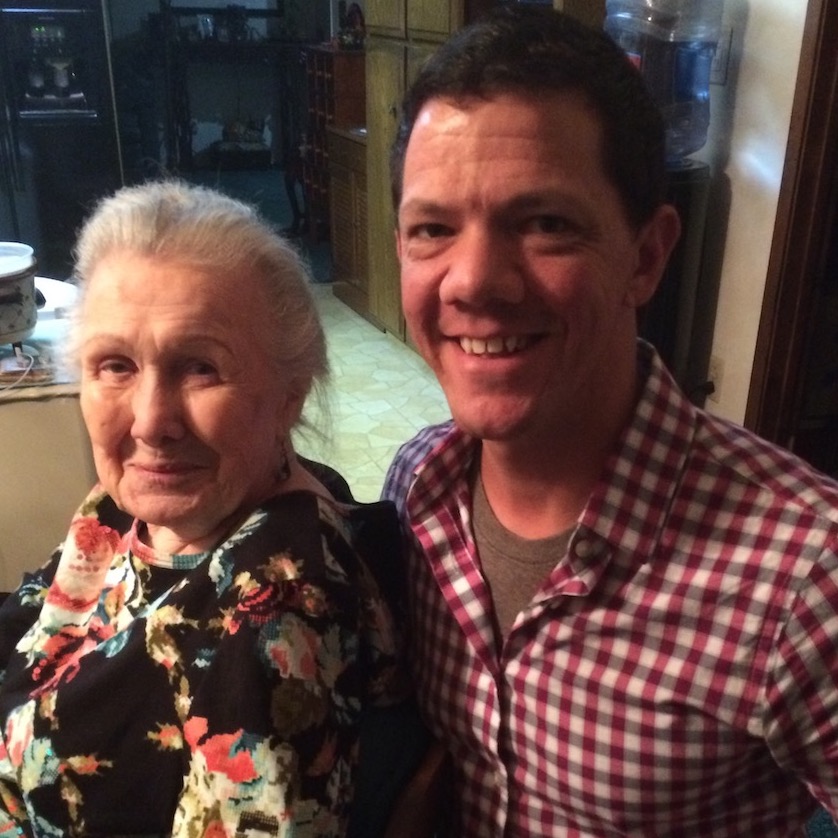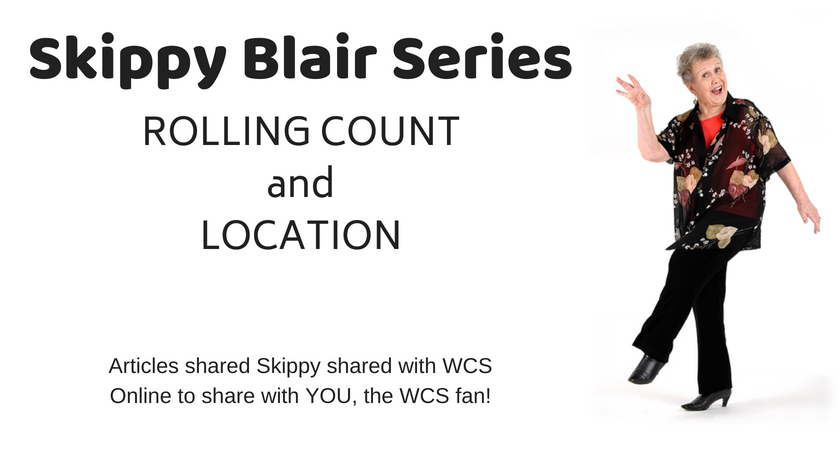In March of 2018 I was able to spend a full day with WCS legend Skippy Blair. At the time of my visit Skippy had just turned 94 years old.
Skippy was instrumental in naming west coast swing in the 1950’s, with helping it become the state dance of CA in the 1980’s and was the co-founder of the WSDC.
During my visit she said to me “Brian, I didn’t plan on living this long but as long as I’m here I’m going to try to contribute.” To that end she allowed me to share some of her work with you through our website. Below is one of the papers she gave me to share with you. Best wishes, Brian B
Wanna learn more about Skippy?
Click here to learn more about here and read our Skippy Series in order.

Skippys words…
The most difficult part
The most difficult concept about counting is the confusion over where the “&” Count and the “a” counts really take place.
Look at the Count comparisons above. Note that the “&” Count and the “a” Count are not located in the SAME place in Rolling Count as they are in Straight Count.
Some people CALL the busier Straight Count – simply leaving out the “e” thinking they are calling a Rolling Count. NOT SO! THINK: Location! Location! Location! The difference is monumental.
ALSO: Be aware that the practice of calling out “1-a2, 3-a4” is really not a valid form of “Rolling Count”. The mind does not distinguish “1&2” from “1-a2”. The rhythmic call of “&a1 &a2 – &a3 &a4” only works when the “&” is clearly called out and FELT. This allows the Center Point of Balance to OWN (and move) on that early “&a” count.
Practice Rolling Count
Practicing Rolling Count develops a habit that puts you in control of your body, not only prior to the weight change, but actually before the receiving foot becomes the sending foot. That action alone produces a dynamic, rhythmic body flow. Leaving out the “&” count takes away the count that actually creates Body Flight. Straight count produces movement that comes from the legs and hips, rather than from the center and the upper body. Counting “e&a1 e&a2” – is simply a busier form of Straight count, but is still Straight Count.
This article is an answer to many emails, as well as personal discussions at Intensives, with people who are serious about learning Critical Timing – (Also from judges who are frustrated with seeing dancers who “Can hit the brakes” on time – and yet do not dance on time throughout the dance). The evidence is overwhelming that the dance is greatly improved by simply changing the way a dancer counts. Swing dancing is continually reaching higher levels of performance. It is important for all of us to explore every possible technique that can help out dance performance grow.
Musicians use straight count
Most musicians use Straight Count. (After all, that’s the way standard music is written) However, certain musicians make us FEEL like dancing. They are the ones who play with feeling. They are the ones who make us want to get up and dance. They bring life to the Music and life to the Dancer. Musicians who are not born with that ability to “SWING IT” can actually learn to feel the music, simply by applying the musician’s ability to read Straight 4/4 time music, and still ROLL the count, or as many musicians would say – Swing it!”. The RESULT is music that inspires us to dance.
Some dancers are actually born feeling great timing and rhythmic expression, (often referred to as “Measured Movement”.) They are one in a thousand but the other 999 can learn to feel those same things by developing a Rolling Count (which puts the feeling into the dancer). AND, even more important, the dancer can learn to exhibit that feeling, even when the music being played is not that great. Many top level dancers are capable of making their bodies flow to a Rolling Count, even when their feet “clip” to a short spurt of Straight Count. That kind of ability and control is the kind of thing that leads to “Star Power!”
Try this experiment:
This is a simple syncopation that most dancers use in West Coast Swing. The “Call” is simply: “Step Kick & Step Cross” on “&a1 &a2”. Dance that syncopation using Straight Count “& 1 & 2” or even “e&a1 e&a2”, both are straight count. This move only works well with Rolling Count. Give it a try and let us know YOUR results.
Rolling Count is a great way to guarantee a rise in your level of performance. Don’t just learn it – OWN IT!
The most requested information
The most requested educational information in 2017 is still about Rolling Count. The printed discovery was in 1998 and it has been raising the level of all different kinds of dancers ever since. If you need more info, please email me at [email protected] – We’ll get back to you.
The continuing use of counting every “&a” is based on the discovery that the & Count belongs to the Center of the body – (The CPB – Center Point of Balance). That discovery has helped us learn to integrate moving the body before we move the feet. This one simple action can lift your level of dance immediately. This discovery of Rolling Count seems to have had a faster impact on our dancers from Europe than here in the states. The past few years have seen dancers from all over the world, (even at Basic levels), using Rolling Count to propel their dancing into a higher level of performance. With Rolling Count, automatically comes a better understanding of the connection between the dance and the music; a higher level or performance.
Musicians and dance
Musicians who understand DANCE, refer to this count by saying “Roll the Count”. Some musicians call it a “Dancers Count”. Some simply say “Swing It”. The term “Swing it”, in this context, really has nothing to do with dancing. It simply means “to play the music with a feeling that “Swings”.
A drill for leaders & followers
The Rolling Count, “&a1 &a2” is the actual full musical count for any 2-beat dance rhythm. Let’s do a simple “Walk-Walk”. This could be simply the two steps walking forward into a Follower’s Left Side Pass or Underarm turn. Leader or Follower could practice the following breakdown: (This simple drill can develop a more professional look in ANY dance done to 4/4 time or 2/4 time music.
Stand with your feet together with full weight on your right foot.
“&a1 &a2” is the count.
First: Practice saying the count until it becomes comfortable. (Note: Stepping twice to two beats of music is called Double Rhythm). Before Count “1” (on the &-Count), tighten the Solar Plexus, lifting the Center of your body. At the time same, press your right foot down into the floor, feeling traction as you press that foot down and back, which will propel your body forward. (The lift and the press on the &- Count, combine to project your Center forward. Our left foot should leave the floor on the “a-Count” Both your “Center” and your Left foot should land forward, precisely on Count -1. (Now repeat that process with the other foot).
Next: On the &-Count (before Count-2), tighten your Solar Plexus, (lifting the body) – Press the left foot down and back into the floor, propelling your body forward. (The lift and press happens at the time same). On the a-Count, the right foot will leave the floor. Your Center and your Right foot will both land forward, precisely on Count-2. (Produces critical timing)
This procedure, repeated over and over again, helps develop Body Flight. Body Flight is that wonderful sense of movement that is visible in our top dancers. (Sensation of feeling air-borne)
Many teachers find the &-Count works better when they use a verbal description for the rest of the count. Simply say: “&a-walk &a-walk.” This teaches the student to Lift on the &-Count, release the free foot on the a-Count and then stop on the verbal command to Walk. This approach helps students who have the tendency to change weight on every sound. For people who have difficulty with Counts, this verbal approach is a great training aide.
I am sure this information will be of great value. Do YOU have a question? Email GSDTA® by contacting [email protected]





 Brian & Megan
Brian & Megan